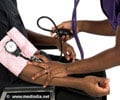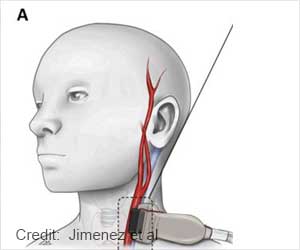Patients whose blood pressure was elevated, but still considered within normal range have a 55 percent higher risk of experiencing a stroke than people without prehypertension.

"The experts reasoned that, generally speaking, the higher the blood pressure, the greater the risk of death and disease, possibly starting from within the normal blood range," said Bruce Ovbiagele, MD, professor of neurosciences at UC San Diego School of Medicine and senior author of the study.
However, Ovbiagele said, conclusive evidence was lacking, "so we decided to compile all the published studies in the scientific literature to date, and using statistical techniques find out if there is indeed a higher risk of future stroke in people with prehypertension, the extent of that risk, and whether particular characteristics were associated with higher stroke risk."
The researchers identified 12 relevant prospective cohort studies of prehypertension. All of the studies were derived from the general population. Four were from the United States, five from Japan, two from China and one from India. Combined, the studies involved more than 518,000 participants and covered periods ranging from 2.7 years to 32 years, with stroke occurrences documented. The prevalence of prehypertension in the studies ranged from 25 to 46 percent. In the United States, it's estimated roughly one-third of adults have prehypertension.
"Overall, people who had prehypertension (in the studies) were at a 55 percent higher risk of experiencing a future stroke than people without prehypertension," said Ovbiagele. "This result held regardless of sex, race-ethnicity, blood pressure type (systolic or diastolic) or the type of stroke (ischemic or hemorrhagic)."
The health risk was measurably greater for those whose blood pressure levels were at the high end of the "normal" spectrum. "We found that those people who fell within the higher range of prehypertension were at 79 percent higher risk of experiencing a future stroke," Ovbiagele said.
Advertisement
Thomas Hemmen, MD, PhD, director of the UC San Diego Stroke Program and a neurologist at the UC San Diego Sulpizio Cardiovascular Center who was not involved in the study, described it as "ground-breaking."
Advertisement
Both Hemmen and Ovbiagele note little empirical evidence exists to show that taking blood pressure-reducing drugs can prevent future strokes. "There just haven't been any large studies," Hemmen said. On the other hand, both doctors say the new findings should encourage persons with high-but-normal blood pressure to change unhealthy behaviors.
"Young and middle-aged persons should check their blood pressure regularly. If they do fall into the higher range of prehypertension, they should take specific steps to modify their lifestyle, such as reducing salt intake and maintaining a normal weight," said Ovbiagele. "Modifying one's lifestyle is relatively safe and could potentially lower not just the risk of future strokes, but possibly other complications of prolonged elevation of blood pressure, including heart attacks, heart failure and kidney disease."
Source-Eurekalert















